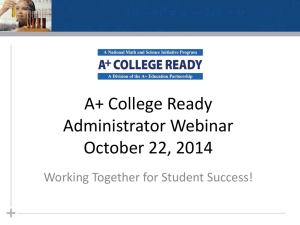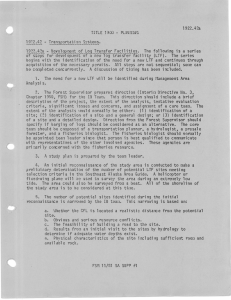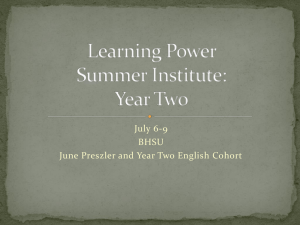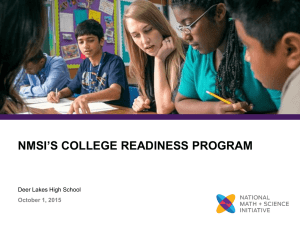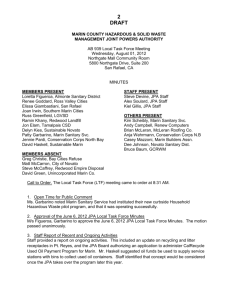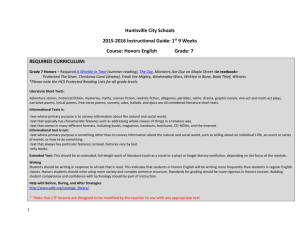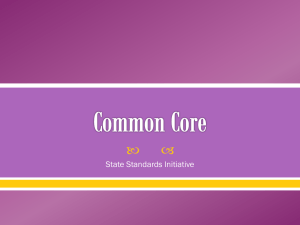Obersvation Protocols for LTF Infused Classes
advertisement
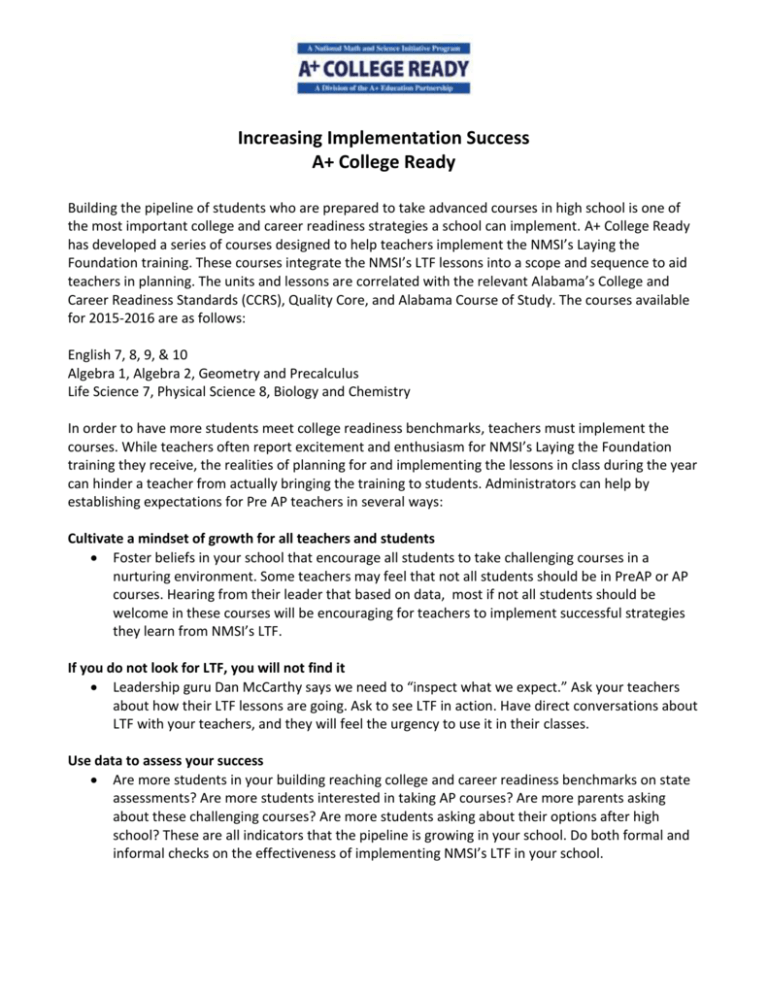
Increasing Implementation Success A+ College Ready Building the pipeline of students who are prepared to take advanced courses in high school is one of the most important college and career readiness strategies a school can implement. A+ College Ready has developed a series of courses designed to help teachers implement the NMSI’s Laying the Foundation training. These courses integrate the NMSI’s LTF lessons into a scope and sequence to aid teachers in planning. The units and lessons are correlated with the relevant Alabama’s College and Career Readiness Standards (CCRS), Quality Core, and Alabama Course of Study. The courses available for 2015-2016 are as follows: English 7, 8, 9, & 10 Algebra 1, Algebra 2, Geometry and Precalculus Life Science 7, Physical Science 8, Biology and Chemistry In order to have more students meet college readiness benchmarks, teachers must implement the courses. While teachers often report excitement and enthusiasm for NMSI’s Laying the Foundation training they receive, the realities of planning for and implementing the lessons in class during the year can hinder a teacher from actually bringing the training to students. Administrators can help by establishing expectations for Pre AP teachers in several ways: Cultivate a mindset of growth for all teachers and students Foster beliefs in your school that encourage all students to take challenging courses in a nurturing environment. Some teachers may feel that not all students should be in PreAP or AP courses. Hearing from their leader that based on data, most if not all students should be welcome in these courses will be encouraging for teachers to implement successful strategies they learn from NMSI’s LTF. If you do not look for LTF, you will not find it Leadership guru Dan McCarthy says we need to “inspect what we expect.” Ask your teachers about how their LTF lessons are going. Ask to see LTF in action. Have direct conversations about LTF with your teachers, and they will feel the urgency to use it in their classes. Use data to assess your success Are more students in your building reaching college and career readiness benchmarks on state assessments? Are more students interested in taking AP courses? Are more parents asking about these challenging courses? Are more students asking about their options after high school? These are all indicators that the pipeline is growing in your school. Do both formal and informal checks on the effectiveness of implementing NMSI’s LTF in your school. Observation Protocol A+ College Ready *Use this protocol in conjunction with Educate Alabama system. Step 1: Pre-Observation Conference Conduct a short meeting – 15-30 minutes – with the teacher in his/her classroom to discuss instructional goals for improvement. Accomplish two goals with this meeting: o Identify 1-3 instructional strategies that the teacher is trying to use in the classroom. o Set a time frame (a roughly two-week period) when the observation could take place. o Present student-level data to the teacher to showhim/her the students’ levels of college and career readiness. NOTE: A+ College Ready recommends instructional goals focus on implementation of NMSI’s LTF lessons and A+ College Ready’s College Readiness curriculum (where applicable). A typical goal should be for 80% or greater implementation of the A+ College Ready curriculum during the course of the year. Step 2: Observation Conduct the observation during the agreed-upon two-week time frame. Record only what you observe for the time you are in the classroom (spend at least 15-20 minutes observing in the classroom if on a traditional schedule; 30-45 minutes on a block schedule) See the attached chart for look-fors. Step 3: Post-Observation Conference Meet with the teacher within a week to discuss the observation. If possible, meet in the teacher’s classroom. Share your observations from the classroom, but not your reflection questions. Simply share what you saw, not your conclusions about it. Discuss how well students are progressing toward college and career readiness goals. Discuss with the teacher the goals set forth prior to the observation. Ask the following questions of the teacher: o How does this LTF lesson fit into the overall unit or topic? o Which LTF lesson or College Readiness skill does this lesson support? o Do you feel that teaching this lesson helped you move toward reaching your instructional goal? In what ways? o What do you feel was strong about this lesson? o What was an area of challenge you felt during this lesson? With the teacher, identify an area(s) of strength the teacher demonstrated during the lesson and an area(s) of opportunity the teacher can work on for the next lesson/observation. Discuss with the teacher the progress on implementing the A+ College Ready curriculum (if applicable). Ask them what is going well and what is not working. Evidence of LTF-Infused Curriculum Student, Teacher, Both Teacher Both Student Evidence of Following an LTF-Infused Curriculum Both Audio and Visual Texts Teacher Modeling classroom and academic behaviors (i.e. annotating, listening, creating products along with students) Student Individual, Small, and Whole Group Learning Both Templates and/or Graphic Organizers Both Use of Technology Both Teacher Engagement and Oral participation Varied instructional strategies/grouping strategies/texts Both Some use of manipulatives Teacher Both Non-traditional arrangement of furniture Engaging Grammar lessons Both Annotation Teacher Work Samples Displayed/Evidence of LTF Lessons Displayed Both Analysis of writing (self and peer evaluation; highlighting; writing samples) Reading small chunks of texts or excerpts Both Module visible and/or in use Use of LTF Content Handouts Individual Writings (dialectical journals, sentences, paragraphs, essays)
